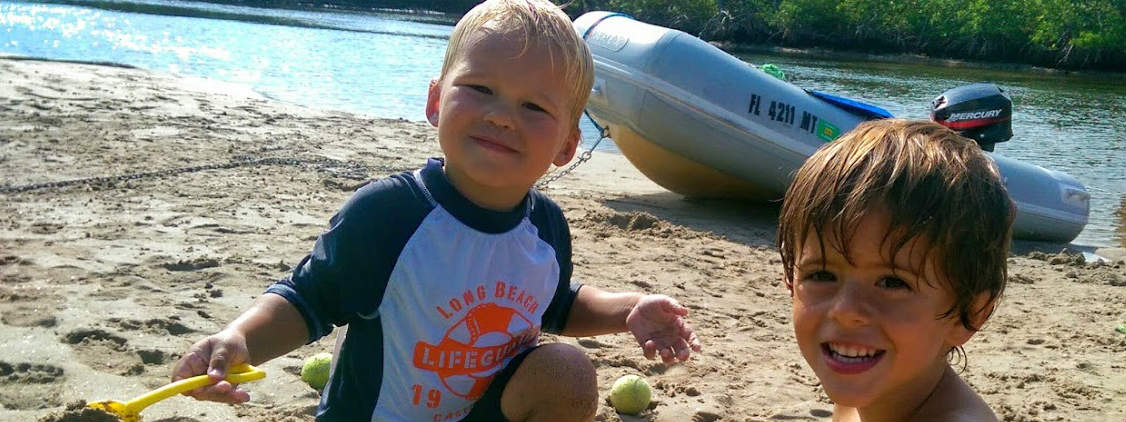
by Michele | Nov 14, 2014 | Preparation Stage

Ethan and Carter making castles on the beach.
Thud. I look up through the companionway to see two blonde heads peering down at Carter and I. “Are we invading?” asks James. They were, but I didn’t mind at all. Since last Thursday when we moved to the Hollywood City Marina, we’ve been in a near-constant state of invasion by the three boys of Viatori: James, Matthew, and Ethan. Carter is absolutely loving his time with other boat kids and we are having a great time talking to their parents, Richard and Leah!
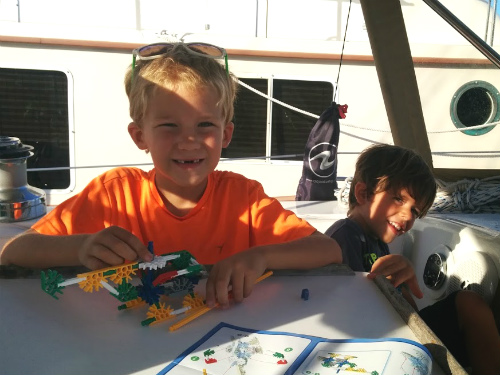
Matthew helped Carter build his K’nex helicopter
Spending the last few days in the company of the Viatori crew has been a great pleasure for us. One of my favorite parts of watching the boys play together is realizing how free of boundaries they still are. No small talk necessary, only an imagination and permission from Mom to go play. Their enthusiasm for life is contagious and their energy seems unlimited at times!

The boys can’t resist reading new books!
While we haven’t had extensive experience with other cruising families, what we have previously heard second-hand about boat kids seems to be fairly true. They are smart and fun, generally good natured, and are very socially adept. In comparison, Carter and I have spent a good amount of time in the company children these last six months who weren’t interested in playing without a screen, couldn’t be bothered by a kid of a different age, or who were downright mean when Carter attempted to join in their fun.
A sample size of one family certainly isn’t enough to make any scientific comparison, but it is enough for me to know that I’m glad Carter can be counted among the boat kids.
If you’d like to read more about the Viatori crew, check out their blog: exceedingthedrift.com.

by Michele | Oct 24, 2014 | Preparation Stage
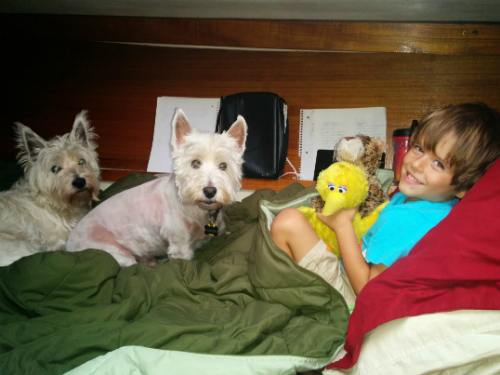
Nothing better than spending a rainy day snuggling in a warm, dry bed
At some point or another, most of us have had to deal with having a small leak in our home or business. A window or even a roof dripping a bit during a flooding spell in springtime is cause for a check up and a few buckets, but not any real concern for most people. Not so on a boat. A primal fear is awakened when you find yourself on a leaking boat in bad weather, even if you clearly are in no danger of sinking or drowning or in fact any horrible fate at all other than a few sopping beach towels lying around and some wrinkled book pages.
Our first big rainstorm on the boat happened just a week or so after moving aboard. Dan was working and I was attempting to turn a very foreign space into our home. As the heavy rain started to fall and the boat began to sway on our dock lines, I started to hear the tell-tale sound of dripping, something I had (naively) never considered when moving aboard. My heart started to beat faster but I decided that the most logical thing to do was to find the leak and write it down so that I could tell Dan about it when he got home in an hour or two. And thus began the hunt, me with my flashlight and notebook scouring every inch of cabinet, hatch and window, all the while becoming more and more panicked as 1 leak become 2, and then 3, and then 10. After my final count of around 15 of so separate dripping areas, I finally sat down on our settee with my face in my hands and sobbed. What had I gotten myself into?
Luckily, Dan had no such fears of our leaking boat and went immediately to work checking out the problem once he had assured me that our boat was, of course, not in danger of sinking. Nearly 6 months later, I’m quite dry while writing this post during a lovely wet spell to say that we’ve finally located and eliminated all of those leaks (for now at least), though we weren’t able to completely accomplish that feat until just a week or two ago. It is amazing how difficult it can be to locate the source of a leak on a rolling object, especially one in which you can rarely see the direct underside of the deck. Now that we are leak free however, the boat feels like a totally different place in a storm; a cozy refuge for our family rather than a derelict tent.
A few things that we have learned through the process of finding our many water intrusions:
- Start with any leaks that are at risk of affecting the integrity of your hull or decks. Luckily we didn’t have any majors so we moved onto the leaks that were easily assessed and fixed, followed closely by those that were the most negatively affecting our comfort. A small leak in the galley is a lot easier to live with than one directly above your bed or bookcase.
- Many times 1 leak can manifest in many different areas of the boat. One of the first and easiest fixes that we found was intrusion where a cable/phone hookup had been removed and not properly covered again. A couple of pieces of duct tape (and replacing the hook-up a few days later) completely eliminated at least 4 different spots that I had marked in one shot.
- Check which way your boat is leaning. To go along with #2, one of our leaks would find its way port or starboard depending on which way the wind was coming from, causing us to think we had separate leaks to fix when there was really only one.
- If you are having trouble locating a leak, you can try using a hose directly on suspected spots. Always check for leaks from the highest point first and make your way down. We started with the cockpit hardware mountings, then moved to the cabin top, etc. before finally getting down to the deck. A word of warning though: make sure that you give enough time for the water to potentially get through before moving on and test it with your boat leaning in different ways otherwise you could miss your leaks if the water is pooling somewhere first (see #3).
- Finally, make sure that when you do find the leak, you fix it properly to avoid any (further) damage, especially in the case of cored decks or hulls. You do not want your leaky hatch bedding turning into a soggy deck!
Hopefully, you’ll find that you look forward to getting out of the rain when you get home, rather than spending the night in it!

by Michele | Sep 26, 2014 | Preparation Stage
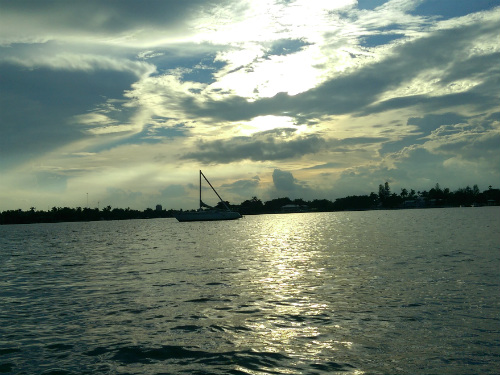
This boat was recently dismasted in an accident involving a drawbridge. I’m sure that’s not exactly the dream that the captain imagined.
Dan and I are not cut out to be live-aboards. And by that I mean living on a boat in a metro area while working full time. Over the last few months, both of us started to become increasingly disillusioned with our dream of cruising and even started discussing what we might do after cruising was over (something that is decidedly not on a set time-line). We are living in a small tiny space with 2 and a half people and 2 dogs, fighting crazy traffic every time we try to go anywhere, Dan working worse hours than anytime in his career, 2,000 miles away from close friends and family, and our marina rent is the same price that we were paying for our mortgage, taxes, and insurance on our pre-downsized house! Conclusion: live-aboard city life is definitely not for us.
It’s easy to see why we might be slightly disappointed. However, when we recently purchased a cruising guide for the Bahamas and started planning the beginnings of our trip for this winter, suddenly a huge light bulb turned on. The reason why both of us had been feeling so discouraged was because we had subconsciously equated our current living arrangements with the dream we had been working and saving towards for the last three years, when the goal was still just around the corner! We want to get away from big cities and stressed out, high-speed life, so it makes perfect sense why we weren’t exactly feeling like we’d found ourselves in Paradise yet.
Now that we’ve realized what was causing some of our uncertainty about cruising, we’re able to move forward with our plans for this winter. The more that we read about and plan for actual cruising, the more energized we’re becoming again. A lot of our biggest projects stopping us from leaving are getting wrapped up and the official hurricane season will soon be over. Let’s just say that we’re getting to the point where the To-Do list is partially getting smaller due to completion and partially due to us making strategic decisions like “new cushions or leaving sooner…screw the cushions they’re fine.” Hopefully sometime soon we’ll be rounding that corner into the final stretch before heading out!
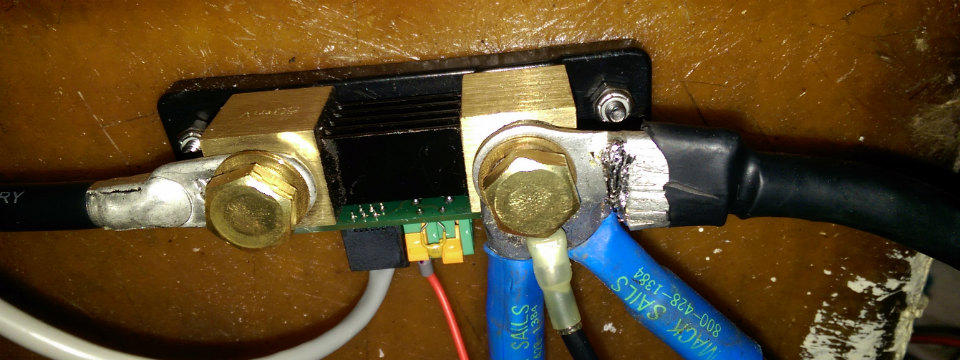
by Dan | Sep 7, 2014 | Preparation Stage
Michele and I are very fortunate to have a plethora of electronic gadgets on our boat. We have a hydraulic autopilot, 4KW HD radar, two vhf radios, 7 inch touchscreen multifunction device (chartplotter), microwave, TV, water pumps, bilge pumps, etc… you get the point. All of these gadgets, both essential and superfluous, take up a surprising amount of electricity. We estimate that our electrical usage while at anchor will be approximately 110-125 amp hours a day. While at sea it will be higher due to the autopilot and radar being active for the majority of the time while sailing. While this is a lot of electrical demand, it is by no means insurmountable with today’s technology.
In this part of the series I will focus on the sizing and selection of our system. The first step in sizing the system was to ascertain what our actual daily usage will be both at anchor and at sea. There are several useful calculators online that give reasonably accurate estimates, but we wanted to go a bit further. We decided to install a digital battery monitor that tells us the percentage charged, amp hours used, amp hours available, current amps, voltage, and historical data so we can know precisely how much electricity remains in our batteries at any given time. The Victron Energy BMV-702 meets all of these needs in a very easy to install and professional looking package.
Most battery monitors utilize a high amperage shunt that is installed between the batteries and load/generation in an electrical system. The shunt is then wired to the battery monitor. With the BMV-702 it is as simple as running a computer network cable (included!) from the shunt to the battery monitor.
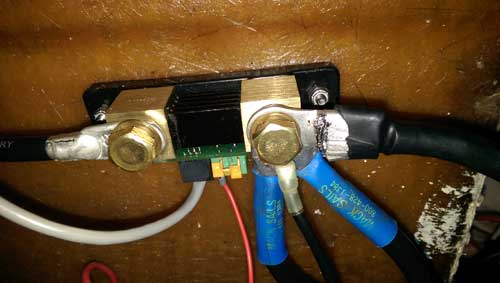
The 50mV shunt I installed for the battery monitor
The next step in the installation of the monitor is to decide where to mount the unit itself. We had a 1970’s era voltage meter that no longer worked taking up a large space in our electrical panel area. After removing the old Danforth meter we had a serious hole left in the bulkhead, however…
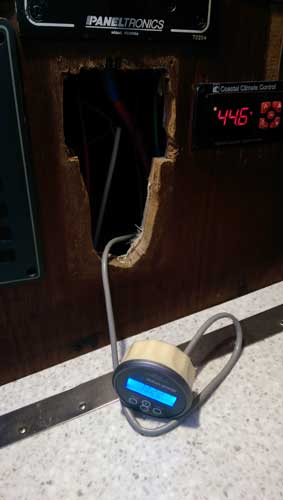
Modern battery monitor size vs 70’s era voltage meter
Thankfully my dad was able to fabricate a black lexan panel that matched our existing panels quite nicely.
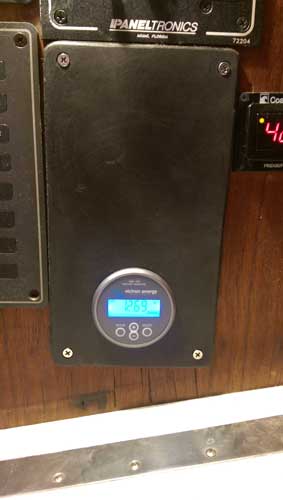
BMV-702 installed with new panel
With the new monitor installed and running, we were able to accurately determine our actual electrical usage averages 90 Ah a day. Granted we are at dock right now so our usage is different than it will be while at anchor, but we now have a very good estimate to size our system with. We decided to add a buffer of 33% to account for increased inverter usage and other possibilities.
To meet all of this electrical demand, many people choose to install and utilize a diesel generator to meet their electrical demands while cruising. This is an acceptable choice for day sailing, hopping between marinas, etc that can quickly become expensive if used as the main source of power for a vessel. The maintenance and fuel for a generator can quickly meet or exceed the maintenance costs of the main engine on a cruising sailboat.
We decided to go with a hybrid setup that utilizes both solar and wind power sources simultaneously. This has the benefit of high power generation while also diversifying the source of power… on rainy days we will generate less solar power, but most likely more wind power. We also will have as a last resort backup our engine alternator that can charge the batteries to nearly full in a few hours. The next part of this series will showcase our solar panel, charge controller, and custom solar panel mount installation.
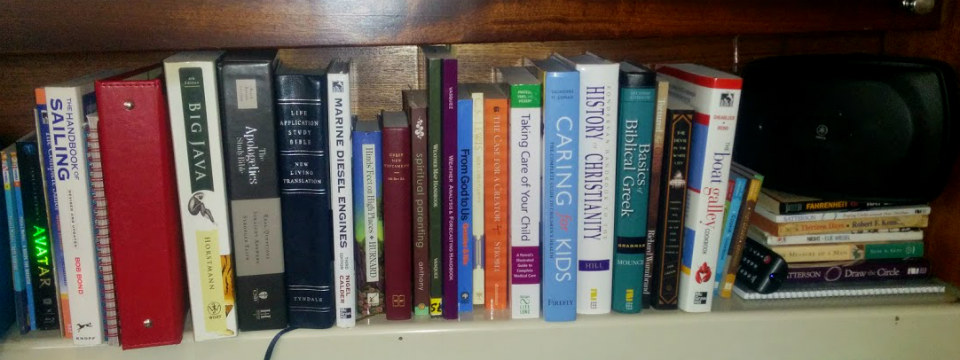
by Michele | Aug 27, 2014 | Preparation Stage
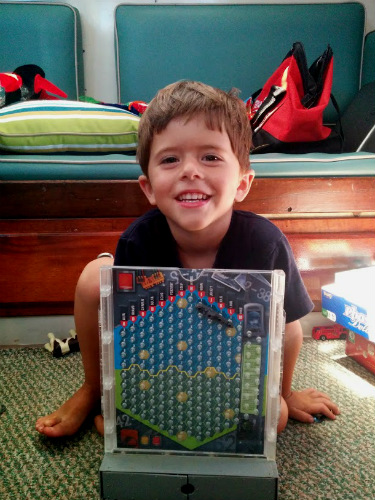
Some games come in more travel friendly shapes and sizes. This is our Battleship game.
In Downsizing for the Boat: Part 1, I talked about how we downsized our big ticket items. Today, I’ll show you something even more critical to living on a boat…entertainment! Board games, DVDs, CDs, and books all have the challenge of taking up a lot of space. I know some people with personal libraries at home that almost require half of their house in shelving (or have to be stored away in boxes)! How do you bring along plenty of entertainment for long days on the water without overwhelming your space requirements?
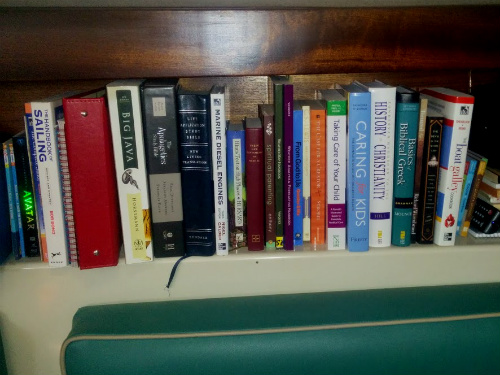
Most of the books we decided to bring were reference guides of some type.
First, let’s talk about books. I am a total book lover, bordering at times on serious addiction. Someone on an online forum recently asked the question, “Could someone recommend a good short book that can be read in about 2 days?” I couldn’t help but laugh, as I had just devoured an entire series in the past two days. The problem with that habit is buying books is expensive and they take up a lot of space. Luckily, with the advent of the ebook (and libraries renting them) my appetite can be sated without breaking the bank or sinking the boat. Most libraries now have the ability to rent a large collection of ebooks at no charge to members, just make sure you have your account set up before leaving and your library card is not going to expire soon.
Before moving aboard, we went through each book in our physical library and asked the tough question, “Are we going to use this while cruising, or not?” If the answer was no, we attempted to sell it on Amazon and eBay. Most got bought up within a month or so and the rest we donated to our local library. (With the exception of our Harry Potter series. Too big for the boat, but no way we could get rid of a collection we grew up on…it’s now taking up precious space in our 2 trunks left behind.) We have 2-Nexus 7 tablets on board as well as a ink-reader Kindle for reading in bright sun. Ebooks are definitely the way to go whether you pay for them or not, as buying and storing books just doesn’t make sense even on a large boat.
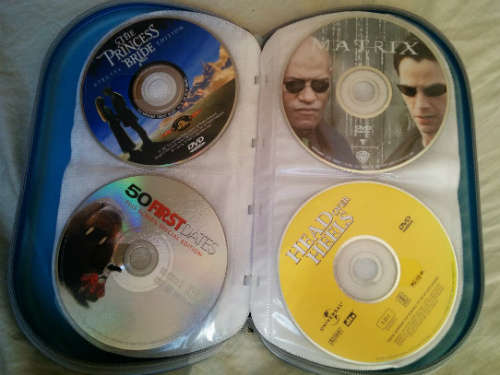
Fitting all of our movies into one case…Inconceivable!
Movies and CDs are a lot easier to downsize, as the main goal is to eliminate the overly large plastic jewel cases and consolidate the discs to a case. Another option is to eliminate the disks all together by transferring all of the movies and songs onto portable hard-drives that you can plug into a computer. We chose to just store our discs in a case since it really didn’t lose a lot of space overall to keep them, plus updating our music collection on our phones (default mp3 player!). One large case and a full recycling bin later and we’ve downsized without actually getting rid of anything. Once again, we couldn’t quite get rid of our collector’s edition Avatar case, because well…its Avatar. So yea.
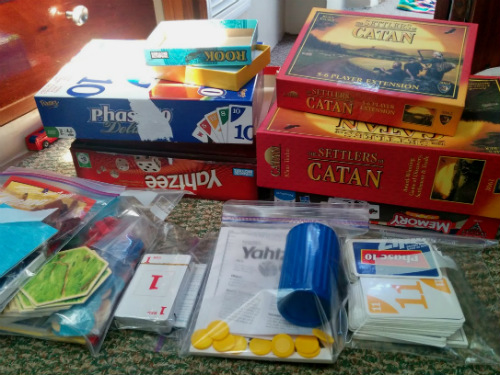
From all of those boxes into the bags. Saving space has never been easier!
Finally, we wanted to bring some board games along, but knew that we didn’t want to store huge game boxes. Luckily, most board games take up very little space once taken out of their original packaging. A few Ziploc bags of varying sizes changed a huge stack of game boxes into one tote bag of fun! Now we have all of our favorite games, i.e. Settlers of Catan, easily available with using up precious space on the boat. All part of the art of downsizing without dumping!


















 We are normal (well ok, not so normal) people that have a dream to see the world and live life as it was meant to be. We both have successful careers in the healthcare industry, even in this terrible economy. We want to break free of the current cycle of trading time for dollars and dollars for more and more things we don't need. So, we have decided to forego the fruits of our economic success and "retire" well before we are 30 and set out to see what is over the Horizon.
We are normal (well ok, not so normal) people that have a dream to see the world and live life as it was meant to be. We both have successful careers in the healthcare industry, even in this terrible economy. We want to break free of the current cycle of trading time for dollars and dollars for more and more things we don't need. So, we have decided to forego the fruits of our economic success and "retire" well before we are 30 and set out to see what is over the Horizon.